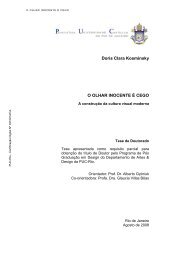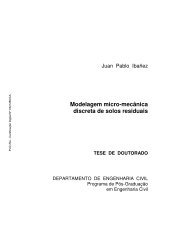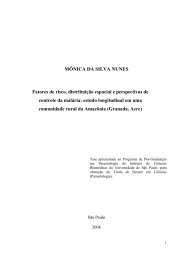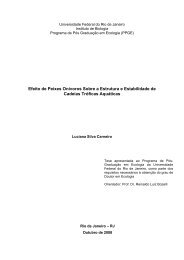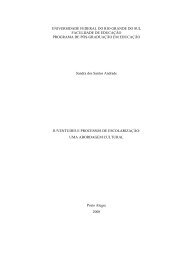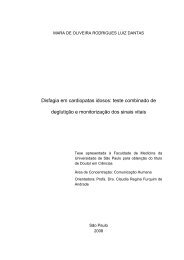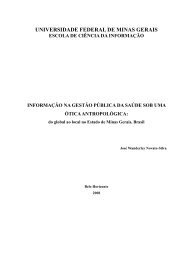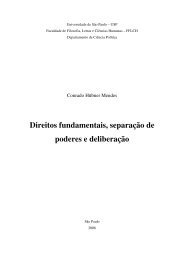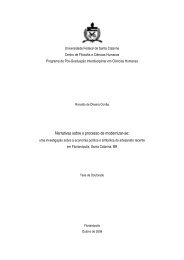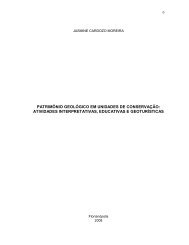You also want an ePaper? Increase the reach of your titles
YUMPU automatically turns print PDFs into web optimized ePapers that Google loves.
R.S. Car<strong>do</strong>so et al. / Molecular Immunology 43 (2006) 464–472 469Table 2Genes differentially expressed (induced) in gamma-irradiated compared to control FTOCs as displayed by the Cluster and TreeView programCluster Gene name Accession no. Chromosome Function1 Myeloblastosis onco<strong>gene</strong> NM10848 10 Onco<strong>gene</strong>Kirsten rat sarcoma onco<strong>gene</strong> 2 NM021284 6 Onco<strong>gene</strong>Cell division cycle 42 NM009861 4 GTPase-signal transductionKu 80, X-ray repair, XRCC5 NM009533 1 DSB repair2 Signal transducer activation of transcription NM011487 1 Transcription factorNeuroprotective protein <strong>gene</strong> AK129214 2H3 Transcription factorNuclear factor of activated T-cells AK048610 18 Induction of cytokines3 Transcription elongation factor 1 AK048564 1H2 RNA pol II transcriptionTranscription elongation factor 3 AJ223472 4D3 RNA pol II transcriptionRunt-related transcription factor 3 AK053910 4 Enhancer binding proteinThyroid autoantigen Ku70 BC051085 15 DSB repairJanus kinase 3 L40172 8 IL2/IL4 signalingInterleukin receptor IL-11TRA2 X98519 4 Immune response/V(D)J recombinationInterleukin receptor IL-7R NM008372 15 TCR V(D)J recombinationTumor necrosis factor, member7 L24495 6 Survival of activated T-cellsGranzyme A M13226 13 Targeting cell lysis4 Fibroblast growth factor receptor 1 BC010200 8 Embrio<strong>gene</strong>sisVascular cell adhesion molecule 1 AK089320 3 Cell adhesionRetinoblastome binding protein 7 BC003785 XF4 Negative regulation of transcriptionSRY-box-SOX-4 AK028989 13 Binding to T-cell enhancerArtemis protein AK052369 2A1 TCR V(D)J recombination5 Mitogen activated protein kinase 7 BC070467 8A1.1 Activation of Jun kinasesInsulin-like growth factor binding protein 7 AB012886 5D Regulation of cell growthA-disintegrin and metalloprotease <strong>do</strong>main 8 BC025584 7F3-F5 Extravasion of leukocytesNuclear transcription factor Y-gamma BC053723 4 Transcription factorTripartite motif protein 28 NM011588 7A1 Transcription factorProtease, serine, 16 (thymus) AK088019 13 Protease, T-cell developmentCalpain 8 NM130890 1H5 En<strong>do</strong>peptidase6 X-ray repair, XRCC4 AK038105 13C3 DSB repairHeat shock protein 1-like D85732 17 Cooperation with chaperonesXPC, xeroderma pigmentozum C AK028595 6D DNA excision repair (NER)Interleukin IL-1B NM008361 2 Immune responseInterleukin IL-2 X01772 3 Immune responseInterleukin IL-6 AK089780 5 Immune responseInterleukin Il-7 AK041403 3 Immune response/ V(D)J recombinationLymphotoxin A NM10735 17 Cytotoxic for tumor cellsCyclin D3 AK046638 17 Protein kinaseEGR1, early growth response 1 M22326 18 Transcriptional regulatorRAG-2, recombination activator <strong>gene</strong> 2 AK040375 2 V(D)J recombinationDNA-activated protein kinase AK088981 16 DSB repair and V(D)J recombinationMMTV en<strong>do</strong>genous retrovirus B4515481 19 SuperantigenDNA cross-link LR1 BC011094 3F2.2 Nucleotide excision repaira cytokine- and chemokine-mediated signaling pathway.Activity-dependent neuroprotective protein <strong>gene</strong> (ADNP, accessionno. AK129214, chromosome 2H3) encodes a DNAbindingprotein with transcription factor activity and nuclearfactor of activated T-cells, cytoplasmic 1 <strong>gene</strong> (NFATC1, accessionno. AK048610, chromosome 18) plays a role in theinducible expression of cytokine <strong>gene</strong>s in T-cells, especially,in the induction of the IL-2 or IL-4 <strong>gene</strong> transcription.The expression patterns of these <strong>gene</strong>s in non-irradiatedFTOCs suggest a tendency of induction at the early stagesand repression at the late stages.Cluster 3 (correlation = 0.71) also encompasses <strong>gene</strong>s involvedin the regulation of transcription such as TCEA1 andTCEA3 (transcription elongation factor <strong>gene</strong> 1, accessionno. AK048564, chromosome 1A2 and <strong>gene</strong> 3, accession no.AJ223472, chromosome 4D3), necessary for efficient RNApolymerase II transcription elongation past template-encodedarresting sites. Cleavage of the nascent transcript by S-II allowsthe resumption of elongation from the new 3 ′ terminus.The Runt-related transcription factor 3 <strong>gene</strong> (RUNX3 <strong>gene</strong>,accession no. AK053910, chromosome 4) codes for a proteinthat binds to the enhancers of T-cell receptor <strong>gene</strong>s. Asenhancers of TRs play a role in the control of <strong>gene</strong> rearrangements(Hempel et al., 1998), RUNX3 could participate in thecontrol of TR V(D)J recombination.G22P1 (Ku70) (thyroid autoantigen <strong>gene</strong>, accession no.BC051085, chromosome 15) plays a role in DSB repairvia nonhomologous end-joining. Ku70/80 heterodimer is the



